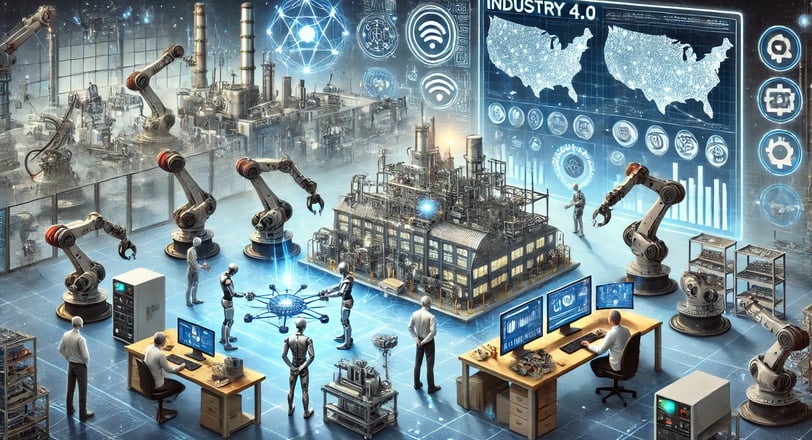The Revolution of Industry 4.0 in the USA: Transforming Manufacturing with Advanced Technology
Industry 4.0, also known as the Fourth Industrial Revolution, is redefining manufacturing and industrial processes worldwide. In the United States, this movement has been essential in modernizing the sector, making it more efficient, secure, and competitive on a global scale. The implementation of technologies such as the Internet of Things (IoT), Artificial Intelligence (AI), Big Data, Digital Twins, and 3D Printing has driven significant innovations, making production more agile and customized.
3/7/20252 min read


The Concept and Foundations of Industry 4.0
Industry 4.0 represents the fusion of the physical and digital worlds, where factories use sensors, networks, and intelligent systems to automate processes, reduce waste, and increase efficiency. The key pillars of this revolution include:
Smart Automation: Collaborative robots and and autonomous systems perform repetitive and hazardous tasks, improving safety and productivity.
Big Data and Analytics: The collection and analysis of large volumes of data enable faster and more precise decision-making.
Internet of Things (IoT): Connected equipment transmits real-time data, facilitating predictive maintenance and operational efficiency.
Additive Manufacturing (3D Printing): Allows for the creation of complex parts on demand, reducing waste and costs.
Digital Twins: Virtual simulations of products and processes to test and improve designs before actual manufacturing.
Examples of Implementation in the USA
In the United States, several companies have led the adoption of these technologies:
General Electric (GE): Uses IoT and AI to optimize turbines and improve manufacturing efficiency.
Tesla: Adopts Industry 4.0 to create flexible and highly automated production lines for electric vehicles.
Boeing: Uses Digital Twins to design and test aircraft, reducing costs and development time.
Amazon: Implemented robots and AI to enhance logistics and inventory management in its distribution centers.
Challenges of Industry 4.0
Despite its advancements, Industry 4.0 faces significant challenges in the USA:
Cybersecurity Risks: The interconnection of systems increases the risk of cyberattacks, requiring investments in digital protection.
Lack of Skilled Professionals: The rapid technological advancement has created a shortage of workers qualified to operate and develop advanced systems.
High Investment Costs: Small and medium-sized businesses struggle to finance the transition to advanced technologies.
Systems Integration: The implementation of Industry 4.0 requires integrating different technologies and legacy systems, which can be complex and time-consuming.
Solutions and Strategies
To overcome these challenges, several strategies are being implemented in the USA:
Investment in Cybersecurity: Companies have adopted encryption solutions and advanced monitoring to protect industrial data.
Professional Training: Educational programs and partnerships between universities and companies are expanding to train professionals capable of working in Industry 4.0.
Government Incentives: Subsidies and financing programs have helped small and medium-sized industries invest in new technologies.
Gradual Integration: Companies are taking a phased approach to digitalization, implementing technology in stages to reduce risks and costs.
Conclusion
Industry 4.0 is revolutionizing manufacturing in the United States, making factories smarter, more efficient, and more productive. With the implementation of advanced technologies, challenges such as security, workforce training, and investment still need to be addressed. However, the digital transformation of the American industry continues at an accelerated pace, ensuring an innovative and highly competitive future in the global manufacturing sector.
Explore
Discover diverse topics in one convenient hub.
Connect
Learn
contact@mindstormblog.com
© 2025. All rights reserved.


